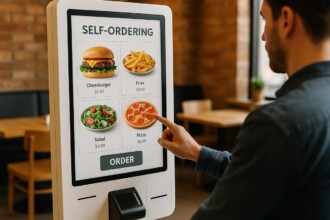Our planet is flooded by myriads of human-made objects and items that end up in landfill everyday and take hundreds of years to decompose. To tackle this issue, the world needs a collective effort. Yet, somehow, numerous legal, business, and individual initiatives have so far failed to make the circular economy a reality worldwide. Perhaps, a little bit of technology could help? Let’s explore whether artificial intelligence (AI) can propel transformative change from the traditional linear model of “take, make, waste” to a sustainable “reduce, reuse, recycle” one.

The 3‘R’s and Circular Economy
The principle of “Reduce, Reuse, Recycle,” commonly known as 3’R’s is a key component of environmental sustainability and waste management. It encourages individuals, businesses and communities to manage their resources and waste in a wise and responsible way that minimises environmental impact.
This principle is the backbone of the circular economy concept. In a circular economy, communities seek to produce zero waste. Item production and consumption there involves sharing, leasing, reusing, repairing, refurbishing and recycling things over and over again to increase their lifecycle and minimise excessive use of resources.
What do we mean exactly when we say “Reduce, Reuse, Recycle”? The first component of the 3’R’s formula presupposes that people are becoming more conscious of what they buy and how they use available resources, to decrease the amount of generated waste and connected CO2, as well as avoid valuable resource depletion. Reusing is one of the ways to achieve that goal. It involves finding new ways to use old items, either for the same purpose or in a completely different role. The items which cannot be reused, are subject to recycling.
In an exemplary circular economy, the life cycle of products is extended, waste and emissions are reduced to a minimum, and items generate more value. The creation of such an economic model would greatly benefit the environment, preserve scarce resources longer, stimulate innovation, boost economic growth and even create a number of jobs. However, reaching this ambitious objective is not that easy.
AI Technology Is Key to Scaling the Reduction Principle
Some examples of reducing the amount of resources used and consumed are using minimum plastic packaging while grocery shopping, relying on renewable energy rather than fossil fuels, choosing durable, long-lasting items over disposable ones, leverage smart home tools to automate heating, cooling, or lighting patterns, decrease water usage and corporate waste at production, switch to digital back-end processes rather than paperwork, and more.
When we speak of corporate sustainability, auditing the company’s workplace to identify ways of reducing waste or energy and water consumption gets more challenging when business expands. However, AI and other innovative technologies can help to scale up the “Reduce” principle across all offices and corporate locations.
To reduce resources used by an organisation, the team needs a thorough understanding of every operation detail, state of the existing equipment and potential improvements, efficiency of the used machinery, amount of paperwork needed for each business process, energy efficiency of the premises, corporate recycling practices, etc.

Taking into account all these factors and, furthermore, extracting some actionable insights from the tons of available data gets much easier with AI. Besides,
- AI can optimise the distribution of electricity in smart grids, balancing supply and demand in real-time, and predicting energy usage patterns.
- Smart systems can optimise heating, ventilation, and air conditioning (HVAC) in both corporate and individual buildings. AI can also analyse energy usage patterns, providing insights and personalised recommendations for reducing consumption.
- Industries with heavy machinery and transportation networks can benefit from AI analysis and predictive maintenance, reducing energy loss due to inefficient operation.
- The technology can analyse data from water supply networks to detect leaks and inefficiencies.
- AI-powered smart appliances, e.g. washing machines, dishwashers, ovens or fridges can optimise water and energy use, adapting their operation to specific circumstances and type of use to reduce utilised resources while maintaining performance.
- AI can analyse your inventory list and product life cycles and find pain points to identify ways of reducing your corporate waste, make your products more durable or optimise recycling practices.
- AI provides insights into employee behaviour and engagement, helping to encourage a culture of sustainability within the organisation.
- The technology can optimise logistics and transportation routes, reducing fuel consumption and emissions.
- Finally, AI is key to automation which helps businesses go paperless.
AI in Recycling
AI-powered software and robot tools have revolutionised the recycling process within the last few years. AI systems offer unprecedented insights into the composition and potential recyclability of waste materials even within mixed waste streams. Smart algorithms can identify and sort different types of recyclables with unmatched accuracy and efficiency.
They can seamlessly detect contaminants in recycled materials, increasing the quality and quantity of recyclables. With the help of AI, sorting waste is more accurate and quicker. Besides, the algorithms may determine the nature of contamination (oil, grease, dirt) early and suggest ways to still turn a particular waste piece into a recyclable one. That’s why less waste ends up in landfill.
Recycling facilities are increasingly employing technologies like optical and robotic sorters to handle the trash. They are faster and more efficient than humans at this job. Besides, AI-powered computer vision is capable of identifying materials across multiple classifications, differentiating between packaging and non-packaging materials, food and non-food grade materials and distinguishing more important nuances allowing for more accurate recycling.
Once computer vision has identified the waste type, an AI robot may automatically pick the item and sort it according to its class. According to Recycleye, its robotic solution has significantly enhanced performance within materials recovery facilities (MRFs). Thus, a Recycleye retrofittable AI-powered robotic waste picking system increased outputs by 10% on a paper line at one MRF, while the firm’s Robotics solution was used to demonstrate how purity could be increased by 8% on aluminium waste.

JD Ambati, CEO of California-based AI and robotics startup EverestLabs also noted that they “have seen plants recover 10, 20, 30% more than what they have been doing previously,” due to the use of innovative recycling practices. The startup’s 3D depth-sensing cameras put on recycling conveyor lines can identify up to 200 items in each frame, helping to increase the potential recovery of recyclable items by three to four times.
In addition, AI may have an impact on recycling even before the waste reaches MRFs. Many people don’t know how to distribute their waste correctly among the recycling bins, eventually slowing down the recycling process at dedicated facilities. AI-empowered applications with in-built image recognition, for instance, could help consumers make the first recycling step more efficiently.
AI Can Increase the Number of Reusable Items
By leveraging AI technologies, companies can create more reusable items that are sustainable, cost-effective, and appealing to consumers. At the design stage, generative AI-powered tools can optimise multiple design iterations based on durability, ease of disassembly, and reusability. With enhanced actionable insights, designers can seamlessly develop products that are inherently more reusable.
AI can also analyse already existing designs and suggest more sustainable or durable alternatives for some item components, materials, etc. Algorithms may provide life cycle assessments to evaluate the environmental impact of a product from creation to disposal.
If utilised in public applications with educational character, AI may suggest to consumers the ways of reusing different items to prolong their life cycle. AI shopping tools focused on sustainability can also provide personalised product recommendations, encouraging consumers to choose reusable items instead of single-use products. This will create more demand for the reusable goods sector.
The AI systems used in recycling to sort and classify the waste are so accurate that they can distinguish, for example, non-recyclable packaging, going as far as identifying the brands on individual items. That might potentially be used in various consumer apps to verify companies’ ESG claims and increase brand accountability on their sustainability commitments.
Bottom Line
Currently, only around 9% of all the plastic waste generated globally is recycled. Most of it (79%) ends up in landfill or in nature, while 12% is incinerated, producing further emissions. As for other types of materials, the statistics are similar: less than 20% of waste is recycled annually, with 80% becoming part of landfill sites.
Moreover, not all people diligently place items in designated bins or properly clean their recyclables before tossing them into a recycling bin or cart. Many people also lack awareness of the potential reusability of the items they possess.
Both of these problems can be solved with the help of AI. This advanced technology can improve the sorting and waste picking processes in recycling facilities. When employed in consumer apps, it can educate people about the 3’R’s principle, help them distinguish reusable items and discover new ways to reduce their individual non-recyclable waste.
Moreover, the use of AI is indispensable in reducing the energy and water use. It can optimise the production processes, building efficiency, logistics, and more to make everyday life much more sustainable and create a solid foundation for a circular economy.









